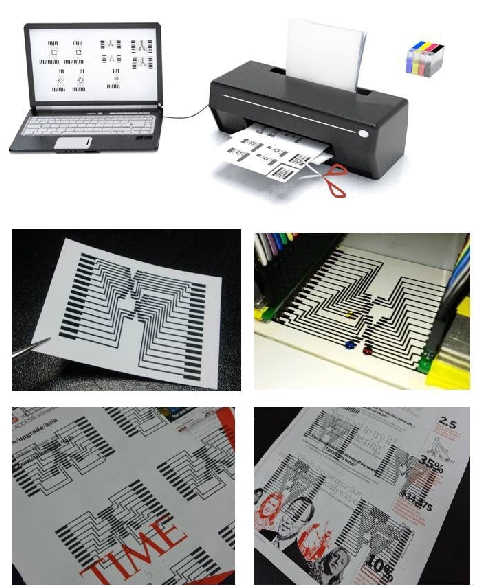A technology to make paper chips by printing on general paper with a home inkjet printer was developed. Because this allows easy production of biosensor chips, it is expected to be adequately utilized for detecting pathogens or pollutants in underdeveloped countries such as Africa and other regions.
The joint research team of Professor Shin Gwan-woo from Sogang University, Professor Kwon O-seon from Chungnam National University, and the Korea Atomic Energy Research Institute announced on the 22nd that they developed an electric active paper chip technology.
Upon developing the technology to electrically drive micro water drops such as blood using conductive ink, they demonstrated paper chips that control the movement time, movement direction, and reaction time of the water drops.
Because conductive ink can be used in home printers, this technology is expected to be applicable to various areas. For example, the paper chips can be applied to sensors for detecting viruses or bacteria.
With conductive ink, the research team printed a fluid chip that can move or mix liquids and cause chemical reactions on various kinds of paper. It is now possible to produce a device that can drive fluids on general paper with electricity even without precise processes in the clean room such as in semiconductor processes for manufacturing electronic chips.
Because this technology can implement every biosensor technology with paper, it can achieve economic efficiency, remote production, local production, easy driving, and environmental issues such as easy waste disposal. They have already applied for patents at home and abroad with the results of their research, and will also apply patents in various derivative applications including pathogen detection sensor, disposable analysis devices, and electric devices. Furthermore, they have plans to use this technology for paper-based liquid lens, displays, and memories.
Especially because chips can be produced easily, this technology could be used in emergency situations in underdeveloped countries where sterile reagents, medical devices, professional medical practitioners are insufficient.
Professor Shin Gwan-woo revealed, "This Korean appropriate technology will be competing with advanced appropriate technologies to be used for the diagnosis of incurable diseases and endemic diseases in Africa and other regions."
This research was supported by the medium researcher support project and the radiation technology development project which were sponsored by the Ministry of Science, ICT and Future Planning and the National Research Foundation of Korea. This study was selected as inside cover paper on the last 16th issue of the international academic journal Advanced Materials which is an international academic
Kwon Geon-ho | wingh1@etnews.com
잉크젯 프린터와 종이로 칩 만드는 기술 개발
가정용 잉크젯 프린터로 일반 종이에 인쇄해 종이칩을 만드는 기술이 개발됐다. 쉽게 바이오센서 칩을 만들 수 있어 아프리카 등 저개발 국가에서 병원균이나 오염물질 등을 탐지할 수 있는 적정기술로 활용이 기대된다.
서강대 신관우 교수와 충남대 권오선 교수, 한국원자력연구원 공동 연구팀은 전기로 구동하는 능동형 종이칩 기술을 개발했다고 22일 밝혔다.
연구팀은 전도성 잉크를 이용해 혈액 같은 미량의 물방울을 종이 위에서 전기로 구동하는 기술을 개발하고, 물방울의 이동시간과 이동방향 및 반응시간 등을 제어한 종이칩을 시연했다.
전도성 잉크는 가정용 프린터에서 사용할 수 있어 여러 분야에 활용할 수 있을 것으로 기대된다. 개발된 종이칩은 바이러스나 박테리아 검출 등을 위한 센서에 응용할 수 있다.
연구팀은 전도성 잉크를 이용해 다양한 종이 위에 액체의 이동과 혼합, 화학반응 등이 이뤄질 수 있는 유체칩을 인쇄했다. 전자칩을 제작하기 위한 반도체 공정과 같은 청정실의 정밀한 공정 없이도 일반 종이 위에 전기로 유체를 구동할 수 있는 장치를 제작할 수 있게 된 것이다.
이번에 개발된 기술은 바이오센서로 활용할 수 있는 기술을 모두 종이 위에 구현해, 경제성, 원격 생산, 현지 생산, 손쉬운 구동, 종이의 손쉬운 폐기 등 환경 문제를 모두 해결할 수 있는 것으로 평가된다. 이미 논문 성과와 함께 국내외 특허출원이 완료됐으며 파생될 수 있는 다양한 분야의 활용가능성, 병원균 탐지 센서, 1회용 분석 기기, 전기구동 디바이스 분야에 순차적으로 특허를 출원하고 있다. 또 액체렌즈나, 디스플레이, 메모리 등도 종이를 기반으로 한 기구에 활용할 계획을 갖고 있다.
특히 손쉽게 칩을 만들 수 있어 멸균된 시약, 전문가용 의료기기 및 전문 의료 인력이 상대적으로 부족한 저개발국가에서 긴급한 상황에 활용할 수 있을 것으로 기대된다.
신관우 교수는 “아프리카 등 난치병이나 풍토병 검진에 활용하는 선진 적정기술에 경쟁할 한국에서 개발된 적정기술이 될 것”이라고 밝혔다.
이번 연구는 미래부와 한국연구재단이 추진하는 중견연구자지원사업 및 방사선기술개발사업 지원으로 수행됐다. 연구결과는 신소재 분야 국제학술지 어드밴스트 머티리얼스 지난 16일자 내부표지 논문에 선정돼 발표됐다.
권건호기자 | wingh1@etnews.com
